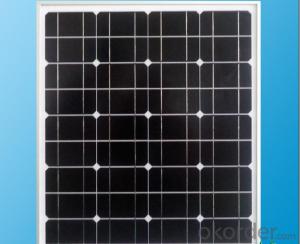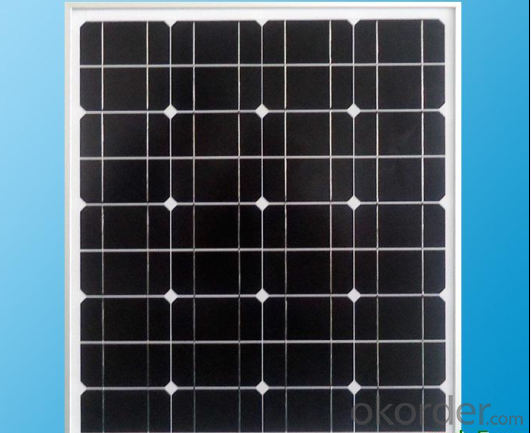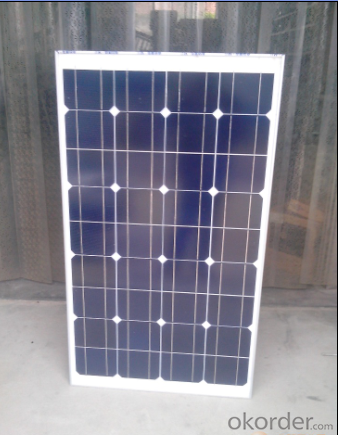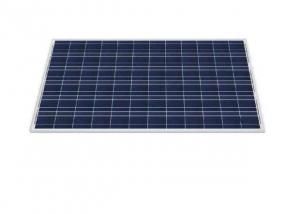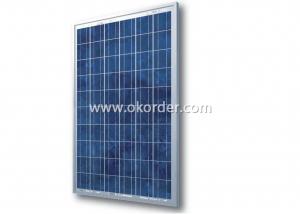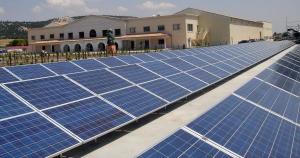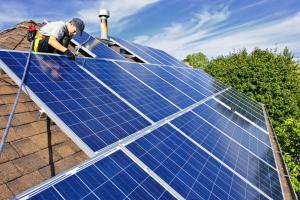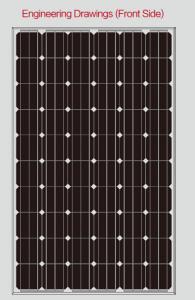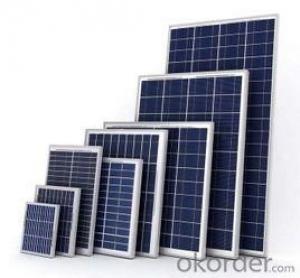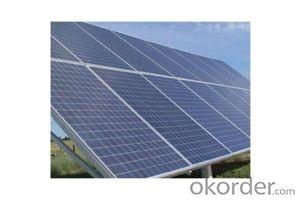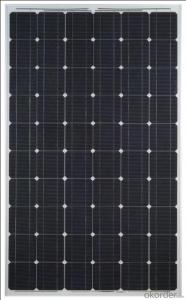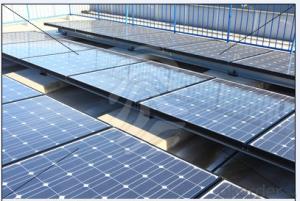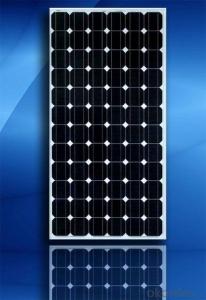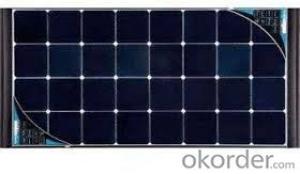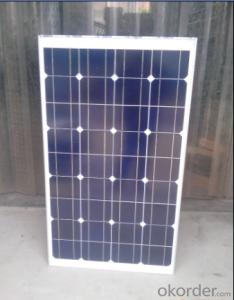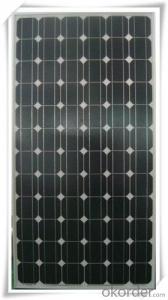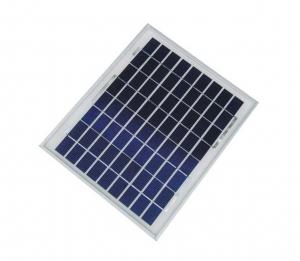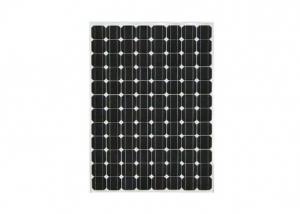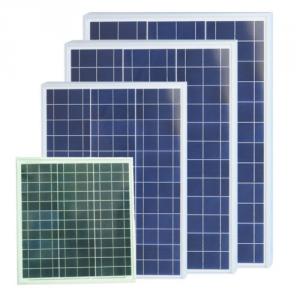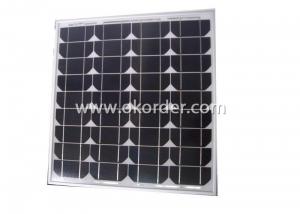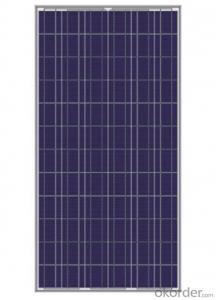FPL & Solar Panels:285W Monocrystalline Solar Panel with 25 Year Warranty CNBM
- Loading Port:
- Qingdao
- Payment Terms:
- TT OR LC
- Min Order Qty:
- 10 set
- Supply Capability:
- 300000 set/month
OKorder Service Pledge
OKorder Financial Service
You Might Also Like
285W monocrystalline solar panel with 25 year warranty
Quick Details
| Place of Origin: | China (Mainland) | Brand Name: | cnbm | Model Number: | PS-M672300 |
| Material: | Monocrystalline Silicon | Size: | 1956*990*40mm | Number of Cells: | 72 pieces |
| Max. Power: | 300W | Weight: | 23kg monocrystalline solar panel | Product warranty: | 25 years |
| Maximum system voltage: | 1000VDC | Tolerance: | 0/+3% | Cable length: | 1.2m |
| Connector: | MC4 compatible connector | Junction box: | IP65 Rated | Frame: | Anodized aluminium alloy |
| Front Cover: | 3.2mm thick.low iron tempered glass | Cell type: | Monocrystalline solar panel cells 156mm |
Packaging & Delivery
| Packaging Detail: | Monocrystalline solar panel packing information 28pcs. / box 20pcs. / pallet 560 pcs. / 40ft 602 pcs. / 40ft (H) |
| Delivery Detail: | in one week |
Specifications
1. Best monocrystalline solar cell price
2. 300W Monocrystalline solar panel with best price
3. 25 years warranty
Product Name
High Efficiency monocrystalline solar cell price with 25 year warranty
Product Description
1.Solar Panel Descprition
PS-M672 Series solar panel is connected in series by 70 pieces of 156mm×156mm Mono Crystalline silicon cells. Solar panel performance is produced according to IEC61215, IEC61730 international standard.
2.Solar Panel Characteristics
1)Manufactured according to international quality and Environment Management
System (ISO9001, ISO14001)
2)High efficiency crystalline silicon solar cells
3)High transmission Iow iron tempered glass, strong mechanical resistance
4)Anti-ageing EVA and excellent anti-climate back sheet
5)Anodized aluminum frame improves load resistance capabilities for heavy wind loads.
6)Standard waterproof junction box
7)High endurance to different weather
8)Good and friendly package with less transportation and storage space.
3.Solar Panel Warranty
1)10 years limited manufacturing warranty
2)10 years for 90% of warranted minimum power
3)25 years for 80% of warranted minimum power
4.Solar Panel Electric Characteristics
| Cell Type | Mono Solar Cell 156mm*156mm | |||
| Item | PS-M672285 | PS-M672290 | PS-M672295 | PS-M672300 |
| Power | 285W | 290W | 295W | 300W |
| Voc(V) | 44.8 | 45 | 45.3 | 345.5 |
| Isc(I) | 8.6 | 8.75 | 8.85 | 8.95 |
| Vm(V) | 36.2 | 36.3 | 36.5 | 36.6 |
| Im(I) | 7.87 | 7.99 | 8.08 | 8.20 |
| Cell Efficiency | 17.08 | 17.38 | 17.68 | 17.98 |
| Module Efficiency | 14.72 | 14.98 | 15.23 | 15.49 |
| Fuse | 15A | |||
| Max System Voltage | 1000VDC | |||
| Cell Number | 72cells | |||
| Tolerance | 0/+3% | |||
| Module Size | 1956*990*40(mm) | |||
| Weight | 23KGS | |||
| Cable Length | 0.9m | |||
| Connector | MC4 or compatible connector | |||
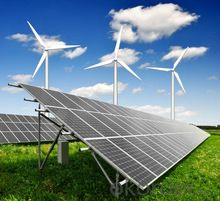
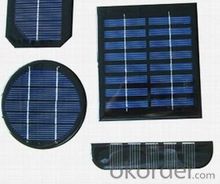
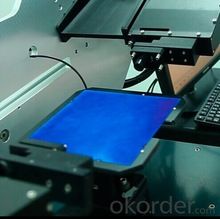
- Q: What are solar panels?
- Solar panels are a collection of photovoltaic cells, that are used to generate electricity, from light. Here is the simple explanation from wikipedia, concerning photovoltaic cells . Photons in sunlight hit the solar panel and are absorbed by semiconducting materials, such as silicon. 2. Electrons (negatively charged) are knocked loose from their atoms, allowing them to flow through the material to produce electricity. The complementary positive charges that are also created (like bubbles) are called holes and flow in the direction opposite of the electrons in a silicon solar panel. 3. An array of solar panels converts solar energy into a usable amount of direct current (DC) electricity. Solar panels are used extensively for power generation in many places, but most space applications (like satellites and spacecraft) use solar panels. If you look at a picture of the current configuration of the International Space Station, the giant wing things are the solar panels.
- Q: can anyone help me? i was thinking of installing solar panels to cut bills but would it be a waste considering its gonna need a circulating pump running almost 24/7 (which will use electricity) and even still will only provide me with quot;warmwater? also would it be possible to install the solar panels for the sole purpose of providing sufficient power to run electric heaters instead of using gas/oil? this way allowing me to have a warm house without the expensive bills. brobably talking about running 7 heaters/electric radiators.
- A thermal solar panel to feed your water heater is the most efficient. But you need a classic heater system too when there is no or little sun. Solar panels to heat a home is not at all recommended. First of all, you get less day light and less sun in winter, so you won't get much electricity. They work best in summer, but electric panels have poor yields and are a very long term investment. You will need to wait years before saving money. Natural gas, a well isolated home, and a good old sweater is the best way to cut bills.
- Q: I'm re-doing my roof. Is it workable?Can I get a government grant or something to put solar panels on my roof?I know they did something like that for windows.
- I don't think you can get a government grant? At least not just yet... But, you can get a nice Tax break for having installed solar panels on your home or for some their backyard works well. But, again you must be aware that having professionals install these panels can be quite costly. If you don't mind getting your hands a little dirty, tackling this project on your own isn't as hard as you might think! And you will be amazed at how much money you can save from the start. And if you get the family involved all the better! Building affordable solar panels for your home, is no pipe dream...But, you must be willing to do the work yourself! That's usually where most people fall short.
- Q: where to find used solar panels?
- Used Solar Panels R Us
- Q: Can solar panels be installed on commercial buildings?
- Yes, solar panels can be installed on commercial buildings. In fact, many businesses are increasingly opting for solar panel installations to reduce their carbon footprint, lower energy costs, and take advantage of government incentives. Commercial buildings often have ample roof space, making them ideal for solar panel installations.
- Q: I am in the market for buying a home. There is one for salke that actually has solar panels on top. How are they used? Do you need to pay for gas and electric still. Does it really light up the house and keep it warm. WHat about the AC keeping hte house cool in the summer does it work for that too? Please explain in solar for dummy terms. I haveno clue about solar panels other thatn the fact that it needs sunlight to run.
- Okay--here it is (without the techie buzzwords!) Solar power has a start up cost--the panels and related equipment. But the amount it cost to operate is virtually zero--pretty much jsut servicing th equipment o keep it working properly--much as you do any other appliance. How much electricity you will still have to buy depends on four things: a) how much your system can produce. If you have a 4000 watt system, you'll still buy a fair amount of power. Abigger one--and you will need less from the power company b) how efficient you (your home and appliances are). The more efficient, the less electricity you use. Obviously, things lie CFL bulbs are very helpful here c) Are you willing to invest in a battery storage system to store electricity from the system for use at night? Right now, that's still pricey. But these are starting to come on th emarket more. If you aren't ready to do tha tnow, you can always add it in later. d) can you sell excess power back to the power company.? In California, the law requires utilities to do this--but its not a universal yet, so it depends on where you are. How this works: you are still hooked up to the power company. Any time you need more power than the solar system produces, yur system jst draws it off the power grid--jsut as always. But--any time you are using LESS than the amount of power your system is producing, the excess automatically feeeds back into the electric grid and a special peter credits you with the power. There are cases wwhere people have goene on a long vacation in California and when they got home, the power company owed them several hundred dollars! You'll need to do some research, price thngs, take your own lifestyle into account, and decide what the best choices for you are. It sounds complicated--and to an extent it is. But the reason is tha tyou have a lot of choices tha tyou can make work to your advantage, instead of jsut writing a fat check to the power company every month!
- Q: How do solar panels affect my electricity bill?
- Solar panels can significantly reduce your electricity bill by producing clean and renewable energy from the sun. By generating your own electricity, you can offset the amount of power you need to purchase from the grid, resulting in lower monthly bills. Additionally, if your solar panels generate more electricity than you consume, you may even receive credits or payments from your utility company.
- Q: Is there a small solar panel system that I can put in my bedroom window and charge my phone and run an alarm clock off of? Or one I can run a microwave off of?
- Yeah they have them to charge phones but to use a microwave you would have to use one to charge a 2 volt battery with them from there an inverter . You could probably get a system like that for around $50 or so off OKorder . Don't get me wrong solar panels do cost allot but for what you want it for just to run a microwave isn't going to cost you all that much . Just go to OKorder and look for solar phone charger and get an idea of what you want . Thumb up for Sam above me . People just think everything is expensive because they put no effort in there shopping .
- Q: but is that per day, per hour or minute?How much watts does the average AC unit use?How much does an energy efficient lightbulb use?All in all let's hypothetically say we no longer use the electric company for our energy source, How many of these panels do you estimate it would take to supply our small home?
- To calculate an estimate of your power usage, follow the first link below. Although you can have whatever sized system you want (at a cost) those on solar power generally keep their power usage down by cooking on gas, not using an electric kettle, using low energy light bulbs. Powering AC would up your power requirements considerably. We run a medium sized house on 860 watts of panels in southern Spain (plenty of sunshine). That includes the washing machine, pool, and running two laptops and wireless network all day,and a ceiling fan on summer nights. Hower we cook on gas, would not consider AC, and the fridge runs on gas (though if the fridge had to be replaced I would buy electric and add an extra pv panel). For an overview of the equipment required and what it does, check the second link below.
- Q: Can solar panels be damaged by hail?
- Yes, solar panels can be damaged by hail. Hailstones can cause physical damage to the panels, such as cracks or shattered glass, impairing their ability to generate electricity efficiently.
Send your message to us
FPL & Solar Panels:285W Monocrystalline Solar Panel with 25 Year Warranty CNBM
- Loading Port:
- Qingdao
- Payment Terms:
- TT OR LC
- Min Order Qty:
- 10 set
- Supply Capability:
- 300000 set/month
OKorder Service Pledge
OKorder Financial Service
Similar products
Hot products
Hot Searches
Related keywords
